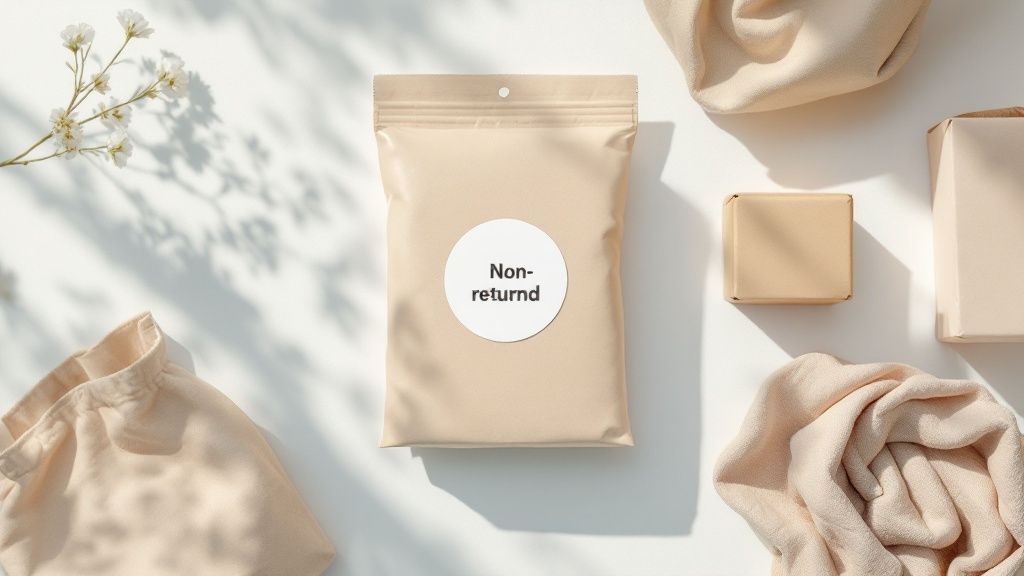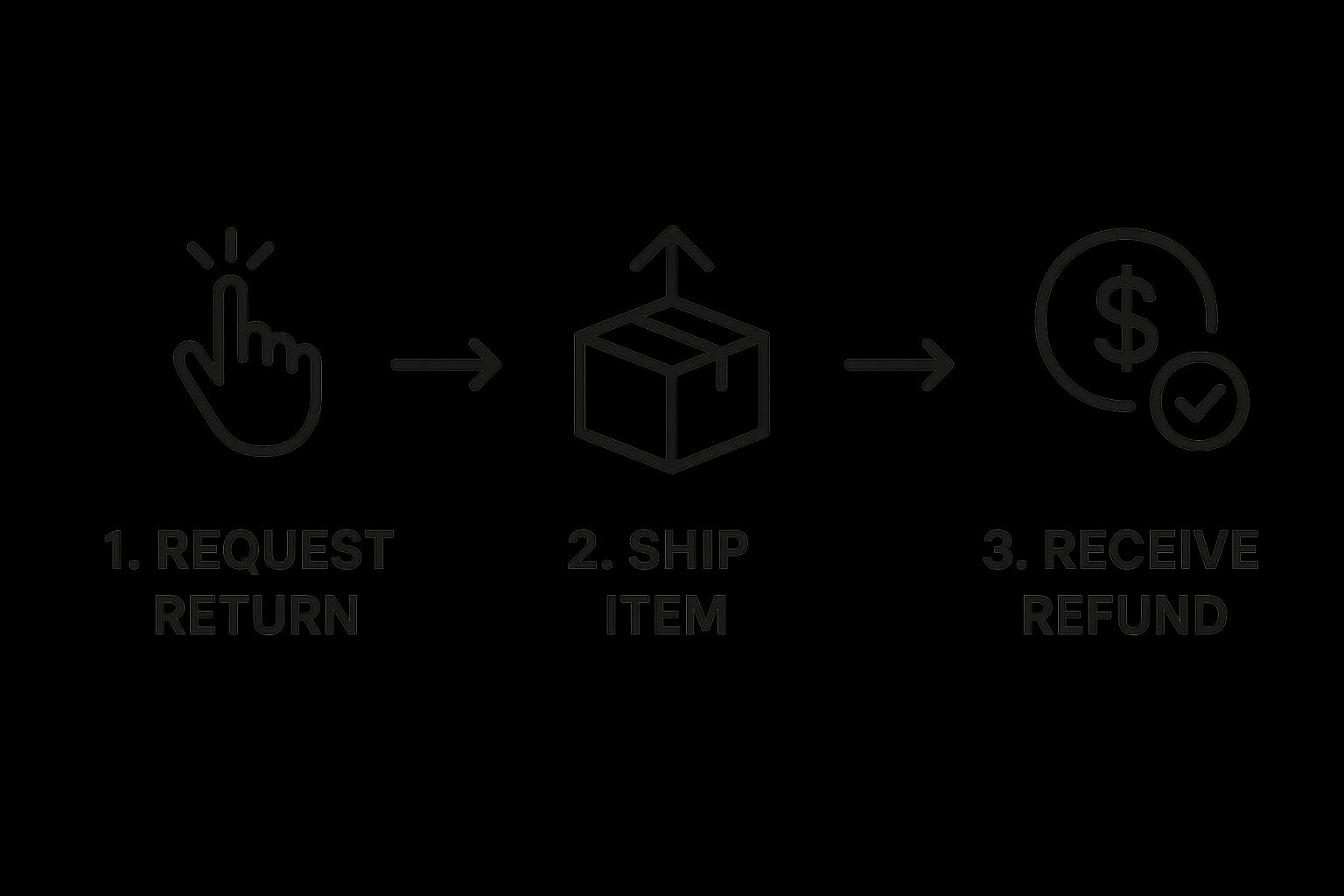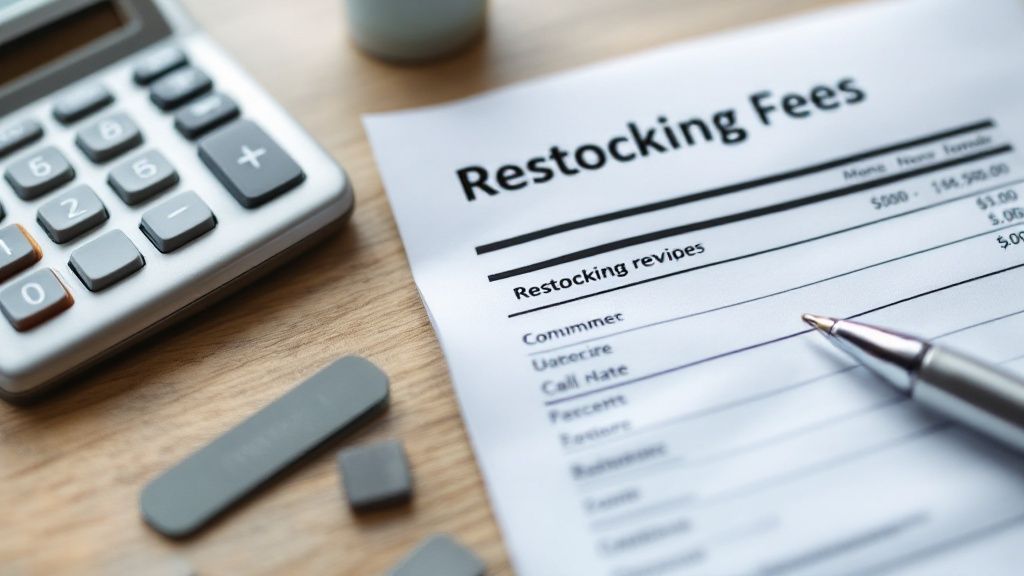So, you’ve clicked “buy,” the package has arrived, and… it’s not quite right. What now? This is where the online shopping return policy comes into play. Think of it as the retailer's rulebook for handling take-backs, exchanges, and refunds for everything you buy on their website.
This policy lays out the entire game plan: how long you’ve got to send something back, what condition it needs to be in, and how you'll get your money back.
Decoding the Modern Return Policy Maze

Ever felt like you need a law degree just to figure out if you can return that shirt that looked different online? You're not alone. Sometimes, these policies feel like they're written in a secret code, full of confusing jargon and sneaky conditions.
But at its heart, a return policy is a promise. It’s the shop’s way of saying, “We’ve got your back if this doesn’t work out.” This is a massive deal when you’re shopping online, since you can't touch, feel, or try on anything before you commit. It’s one of the key differences we explored in our guide on online shopping vs in-store shopping.
Key Elements of a Return Policy
No matter how long and wordy they get, most return policies boil down to a few key ingredients. Once you know what to look for, you can size up any store's rules in seconds and shop with a whole lot more confidence.
- The Return Window: This is your deadline. It’s the set amount of time you have to start the return process, usually somewhere between 14 and 90 days from when you bought or received the item.
- Condition of the Goods: This part spells out what shape the product needs to be in. Most of the time, it means unworn, unused, and still in its original packaging with all the tags attached.
- The Refund Type: This tells you how you'll be compensated. Will you get a full refund to your credit card? Or will it be store credit for your next purchase, or maybe a straight swap for a different size or colour?
These rules aren't just there for fun; they have a huge impact on a business's bottom line. In Australia alone, the online shopping boom has led to a returns problem costing retailers a staggering $20 billion a year. With around 30% of all online purchases getting sent back, you can see why companies are so specific about their policies.
A great return policy is more than just logistics; it's a powerful tool for building customer trust and loyalty. When shoppers feel secure, they're more likely to make a purchase and return for future business.
Getting comfortable with reading these policies is your secret weapon. It’s the first step to becoming a savvy online shopper who never gets stuck with a purchase they don’t love.
Why Free Returns Are Quickly Vanishing
Remember the good old days of online shopping? When "free returns" felt less like a perk and more like a given? You could order three different sizes of the same pair of jeans, try them on at home, and send back the two that didn't fit without spending a cent. Well, those days are fading, and it's not just your imagination.
That golden era of easy, no-questions-asked returns was a wild party for shoppers, but now the retailers are dealing with the financial hangover. The "bracket buying" culture—where we buy multiple versions of an item knowing we'll return most of them—really took off during the pandemic, and it’s created a massive logistical headache for businesses.
The Hidden Costs of a Return Trip
When you send an item back, it kicks off a surprisingly complex and costly journey behind the scenes. It's not as simple as slapping a new label on the box and sending it on its way. This whole process is called reverse logistics, and it's a beast.
Each returned product has to be:
- Shipped back to a warehouse (and postage isn't cheap!).
- Received and unboxed by a real person.
- Inspected for damage, wear, or missing tags.
- Repackaged, restocked, repaired, or in some cases, just thrown out.
Think about the labour involved. Someone has to open every single package, meticulously check the item's condition, and decide what to do with it next. Even a perfectly good t-shirt needs to be refolded, put in new packaging, and entered back into the inventory system. All of that costs time and money.
For most businesses, especially smaller ones, footing the bill for every single one of these return trips just isn't sustainable anymore. The numbers tell a pretty dramatic story. A recent study found that only 14% of Australian retailers now offer free returns, which is a massive drop from 49% just a few years ago. It’s a clear sign the industry is hitting the brakes after realising the free-for-all was bleeding them dry. You can dive deeper into the stats on how Australian retailers are rethinking free delivery and returns.
A "free" return for the customer is never actually free for the business. That cost gets absorbed somewhere, either through higher product prices for everyone or, as we're seeing now, the introduction of return fees.
So, What Does This Mean For Your Shopping Cart?
This new reality means you'll need to keep a closer eye on the online shopping return policy before you click "buy." You're far more likely to see a small fee deducted from your refund to cover the return postage, or encounter stricter rules about what you can send back and in what condition.
This isn't about punishing you for making a return. It's a tough but necessary adjustment for businesses trying to manage the expensive, tangled web of online returns. Knowing this helps you become a smarter shopper, encouraging more considered purchases and setting the right expectations for when that item that wasn't quite right needs to make its way back.
Getting to Know Your Consumer Rights in Australia

Here’s something every Aussie online shopper should tattoo on their brain: a store’s return policy never overrides your legal rights. While a business can set its own rules for “I just changed my mind” returns, a powerful piece of legislation called the Australian Consumer Law (ACL) has your back when things go properly wrong.
Think of it this way: the store's policy handles the moments you have a change of heart. The ACL steps in when the product fails you. It's a critical difference between a simple case of buyer's remorse and a genuine problem with what you paid for.
When an Item is Faulty, Damaged, or Not What You Ordered
The ACL gives you automatic protections, known as consumer guarantees, every single time you buy a product or service. These guarantees are the law’s promise that goods will be of acceptable quality, fit for their purpose, and match the description or sample you were shown.
So, if that new gadget arrives with a suspicious rattle, a supposedly "waterproof" tent lets in the morning dew, or the stunning turquoise rug from the website shows up as a sad, washed-out teal, the ACL kicks into gear. The seller is legally required to provide a solution, or what's called a 'remedy'.
Your consumer rights are not optional extras. It’s illegal for a business to claim they have a blanket “no refunds” policy or to simply fob you off to the manufacturer without trying to help you first.
The remedy you're entitled to—whether it’s a repair, a replacement, or a full refund—hinges on whether the problem is a minor or major fault.
Let's break that down. A table is often the easiest way to see the difference between returning something because you've changed your mind versus returning it because it's faulty.
Change of Mind vs Faulty Item Returns Under ACL
| Scenario | Your Rights (Change of Mind) | Your Rights (Faulty or Not as Described) |
|---|---|---|
| Why You're Returning | The item works perfectly, but you don't want it anymore. Maybe the colour isn't right for your room, or you found a better deal elsewhere. | The item is broken, unsafe, doesn't work as advertised, or is significantly different from the online description. |
| Legal Entitlement | None under the ACL. Your right to a return is determined entirely by the individual store's policy. They can offer an exchange, store credit, or even refuse the return. | You are legally entitled to a remedy. The type of remedy depends on whether the fault is minor or major. The business must help you. |
| Who Decides the Outcome? | The business. They dictate the terms of the return, including timeframes and whether you get a refund or credit. | For a minor fault, the business can choose to repair, replace, or refund. For a major fault, you get to choose between a refund or a replacement. |
As you can see, the law draws a very clear line. The reason for the return is everything.
So what makes a fault "major"?
-
A minor fault is a small issue that can be fixed pretty easily and quickly. Think of a shirt with a loose button or a picture frame with a small scratch on the back. For these, the business can choose to repair it, swap it for a new one, or give you your money back.
-
A major fault is a deal-breaker. The item is unsafe, significantly different from how it was described, or is completely unfit for its purpose and can't be easily fixed. A classic example? You buy a brand-new lawnmower that refuses to start, no matter what. That’s a major fault.
In that lawnmower scenario, you call the shots. You can demand a full refund or an identical replacement. The store can't just force you to accept a repair. Understanding this power dynamic is your secret weapon for stress-free returns. Any good online marketplace in Australia will have its policies clearly laid out to reflect these rights, making sure you shop with confidence.
Taking on the Return Process Step by Step
Alright, so the package has landed, you’ve ripped it open, and… yeah, it’s not a keeper. Don’t panic. Sending something back these days isn't the mission it used to be. Once you know the drill, it’s less of a bureaucratic nightmare and more of a simple to-do list.
Think of it as a three-part play: kick things off, send it on its way, and wait for the cash to come back.
Kicking Off Your Return Request
Your first move is always online. You’ll need to pop back over to the retailer’s website and hunt down their returns portal. It’s usually hiding in your account section or tucked into the website’s footer. This is where you officially raise your hand and say, “Hey, this is coming back to you!”
Once you’re in the portal, it’s generally a piece of cake. You’ll find your order history, select the item that’s a dud, and pick a reason for the return. It pays to be honest here—whether it’s a wonky fit, it arrived busted, or you just plain changed your mind.
This is also where you’ll sort out your return label. A lot of places now give you a nifty QR code, which saves you from that desperate, last-minute hunt for a printer. The system will tell you who’s footing the bill for postage; sometimes it's on the house, other times they'll dock a small fee from your refund.
Pro Tip: Before you do anything else, check the return window! Most retailers give you somewhere between 14 to 30 days. Missing that cutoff is the number one way to get your return knocked back, so don’t dawdle.
To make it even clearer, this infographic maps out the whole journey for a smooth, successful return.

As you can see, it’s a pretty seamless flow from lodging your request online to shipping the item and, finally, getting your money back. What seems like a chore is really just three straightforward steps.
Packaging and Posting Your Item
With your return label or QR code in hand, it's time to play Tetris with the box. Retailers really, really prefer you use the original packaging if it's not completely trashed. It’s not just about looks; it's designed to keep the item safe on its trip home.
Just before you tape it up, snap a quick photo of the item inside the box. Trust me, this tiny step can be a total lifesaver if any arguments pop up later about whether it was damaged when it got back to the warehouse. Think of it as your own little insurance policy.
Once it's all sealed up, just follow the shipping instructions. This usually means one of a few options:
- Dropping it off at a post office, like your local Australia Post.
- Sticking it in a parcel locker for a courier to grab.
- Booking a courier to come and pick it up right from your doorstep.
Whatever you do, always get a receipt or a tracking number. This is your golden ticket—proof that you've done your part and sent the item back. Without it, you're up the creek if the package decides to go on an adventure of its own. Once it’s away, all you have to do is sit back, track its progress, and wait for that sweet, sweet notification that your refund is on its way.
Who's Behind the Returns Boom?

So, why has sending something back turned into such a massive deal in Australian retail? It’s not just about couriers and warehouses; it’s about who is doing the shopping and, crucially, how they're doing it. A new wave of shoppers with entirely different expectations is rewriting the rules.
Younger shoppers, especially Gen Z and Millennials, grew up in a world where the bedroom is the new fitting room. They've perfected the art of "bracketing"—that savvy (and slightly chaotic) trick of ordering an item in a few sizes or colours, knowing full well most of it is going straight back. It's a clever strategy to find the perfect fit without ever leaving the house.
This isn't just some quirky habit. It’s a total shift in shopping behaviour, and retailers are racing to keep up.
The Try-Before-You-Buy Mentality
For these digital natives, a flexible online shopping return policy isn't a nice little bonus; it's a non-negotiable part of the deal. They see returns as a built-in, expected step in the whole shopping journey. This mindset is dialled up to eleven by the rise of social commerce, where a quick tap on a TikTok video can lead to an impulse buy.
When you buy something on a whim, the chance of it being sent back goes through the roof. Maybe the item doesn't quite live up to its filtered, influencer-endorsed hype, or perhaps a dose of buyer's remorse kicks in the next morning. This cycle of instant purchase followed by an easy return has simply become the new normal.
The modern fitting room isn't in a shop anymore; it's your living room. Shoppers now expect the freedom to try on, test out, and send back whatever doesn't make the cut, all from the comfort of home.
Understanding this generational shift is everything. A smooth returns process is a make-or-break part of the experience. A recent survey found that 72% of Gen Z and Millennials demand easy returns, compared to just 65% of shoppers overall. And here's an interesting tidbit: while most Aussie shoppers want their money back, only 42% of retailers currently offer cash refunds over store credit. You can dive deeper into the latest Australian e-commerce trends to see what else is happening.
This generation isn't just buying products; they're buying experiences. A clunky, difficult, or costly return process is a major turn-off that sends them running to a competitor. That’s exactly why retailers are constantly tweaking their policies to meet these new, sky-high expectations.
Pro Tips for a Hassle-Free Return Experience
Alright, let's turn you into a returns ninja. Getting your money back for an online purchase shouldn't feel like navigating a maze blindfolded. With a few clever habits, you can make every return a ridiculously smooth and successful mission.
Think of yourself as a savvy detective, both before and after you hit that 'buy' button. Your job is to gather the clues and evidence needed to make your case airtight, leaving no room for nasty surprises.
Before You Even Click ‘Buy’
Honestly, the best return is one you’ve prepared for before the item is even yours. A little bit of prep work now can save you a world of pain later.
- Screenshot the Policy: Don't just skim the online shopping return policy—capture it! Retailers can update their terms without notice. A dated screenshot is your golden ticket, proving the rules you agreed to when you made the purchase.
- Hunt for the Fine Print: Dive into the details. Are there sneaky restocking fees? Do they fob you off with store credit for sale items? Knowing this stuff upfront is the difference between a refund and a regret.
Being on the ball from the get-go sets you up for an easy win. This proactive mindset is a huge part of learning how to shop online safely, protecting not just your wallet but your sanity too.
After the Parcel Arrives
The moment that box lands on your doorstep, the return clock officially starts ticking. You need to act fast and document everything.
From the second you decide an item's going back, treat it like a precious artefact. The condition it's in—and your proof of it—directly dictates how quickly and successfully you'll see your money again.
Hold onto all the original packaging. We're talking the box, the tissue paper, the weird little plastic bags, and especially the tags. Retailers are far more likely to process a speedy refund if they can pop the item straight back on the virtual shelf.
Before taping up that box, snap a quick photo of the item nestled inside. This is your visual proof that the product was in perfect, as-new condition when it left your hands. Then, when you post it, always get a tracking number. Seriously, this part is non-negotiable. It's your undeniable proof that you sent the parcel and lets you watch its journey back to the warehouse. Following these simple steps puts you firmly in the driver's seat.
Got a Question About Returns? We’ve Got Answers.
Still got a few nagging questions about the whole online shopping returns dance? You're not alone. Let's clear up some of the most common head-scratchers Aussie shoppers face when sending something back.
Wrestling with a return can feel like you're trying to learn a new board game on the fly, but once you get the hang of the basic rules, you’ll feel like a pro.
Can a Shop Actually Refuse My Return?
Short answer: yes, but only under specific circumstances. If you're sending something back simply because you had a change of mind, a store is totally within its rights to say "no thanks," especially if you've missed their policy deadline. For buyer's remorse, they make the rules.
But here’s the kicker: if the item is faulty, broken, or wildly different from its description, they absolutely cannot refuse your return. That's where your rights under the Australian Consumer Law (ACL) come into play, legally requiring them to sort you out with a repair, replacement, or refund.
Do I Have to Fork Out for Return Shipping?
This is the big one, and it all boils down to two things: the store's policy and why you're returning the item.
- For change-of-mind returns: Most of the time, you'll be the one footing the bill for return postage. Those glorious days of free returns for any reason are becoming a bit of a unicorn, so always read the fine print before you hit "buy".
- For faulty items: Now, if you've been sent a dud, the seller is on the hook for the return shipping costs. You shouldn't be left out of pocket because of a defective product. Simple as that.
How Long Until I See My Money Again?
We all want our cash back yesterday, but a little patience is needed. Once the shop gets your item back and gives it a once-over, they usually process the refund within 5-10 business days.
Just remember, even after the retailer hits 'refund' on their end, it can take another few days for the money to actually land back in your bank account or show up on your credit card. That part’s up to the banks!
Always hang onto your return tracking number. It’s your proof of when the parcel landed back at their warehouse. If a couple of weeks go by and you've heard nothing but crickets, it's definitely time to shoot a polite follow-up email to their customer service team.
Ready to shop with zero stress? At AMI Cart, we keep our returns simple and straightforward, so you can focus on the fun part—finding things you’ll absolutely love. Explore thousands of products with a policy designed with you in mind. Shop now at AMI Cart




